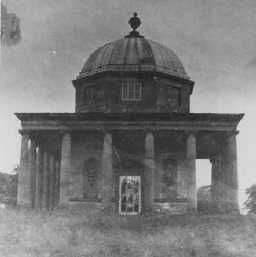Folly
A decorative building or structure often built as part of a landscaped park or estate of a country house. These may have been specially designed by an architect to fulfil an entertainment function, such as a place for picnics or as a hunting lodge, or commemorative or of no function - but entertainment itself as a flight of fancy. Follies could therefore be nonsense buildings - with rooms or staircases that might lead nowhere, or be built already as ruins. Sometimes they were added to - but again in deliberately ruined portions. (Compare with ferme ornee). Statues might be employed in niches of appropriate figures. A grotto is a further type of folly. Prehistoric standing stones and Roman materials could be acquired for display or re-created as a small folly, from local or exotic sites. A standing stone was taken from a near a barrow at Shaftoe for 'use' at Wallington, Northumberland.
These buildings could derive inspiration from Classical temples, or Medieval tower houses - though follow no style totally, sometimes as a pastiche of the original forms being called Gothick. Follies often followed the fashion of the day - 'Chinese' and 'Egyptian' forms being built in the 16th, 17th and 18th centuries - though most northeast examples are of the Gothick type. There was a 'Chinese' wooden pavilion erected at Wallington - the (again false) style being called Chinoiserie - in the 18th century, but this rotted away, where only the Chinese pond remains. Many follies remain around country estates - there are two surviving clusters around Wallington and Alnwick of predominantly18th century date. There might also be legends about follies - such as secret tunnels, or how long things took to build. An example is Starlight Castle, Seaton Sluice, reputed to have been built over one night.
To explore more glossary entries click on a letter.
